Review: G-Tech’s G-DRIVE Thunderbolt 3 is a sleek & versatile high-capacity drive
posted Monday, February 12, 2018 at 3:00 PM EST
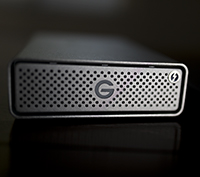
There are different types of hard drives for different uses in my workflow. For single or dual drive arrays, I generally keep them under my monitor stand as a “business” or documents repository. I also use them to send footage across the country for various reasons. This is their designation because I don’t need a lot of speed for those kinds of duties, and single and dual drives generally don’t provide fast enough speeds for my daily editing needs.
Generally. Not all the time though. That can change.
In the case of G-Technology’s latest G-DRIVE featuring Thunderbolt 3, this single drive solution plays multiple roles for me because of its speed, weight, size, build quality and connection options.
The G-DRIVE Thunderbolt 3 is anything but flashy, and I like that. It’s a simple metallic rectangle with subdued branding and minimal design. The face of the drive is a grate with a light-up “G” in the center that glows and flickers with the drive’s activation. The rear of the drive features three connection ports (two Thunderbolt 3 and one normal USB-C), a power port, and an on/off switch. The G-DRIVE ships with a Thunderbolt 3 cable, but also works with a regular USB-C cable, and a USB-C to USB-A cable, of which I have several kicking around my desk drawer. With those three cable options, there are very few computers out there that this drive won’t connect to and work with.
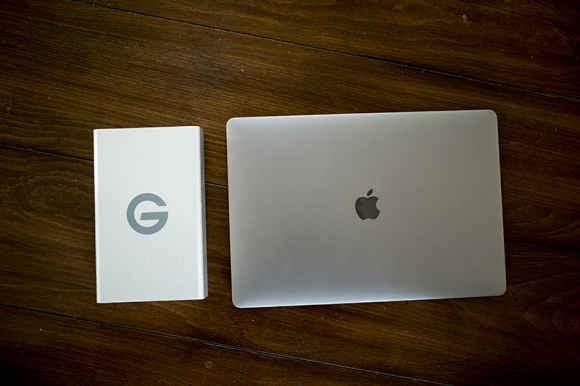
Though the G-DRIVE Thunderbolt 3 is formatted for Mac (macOS 10.12 and up), it can easily be reformatted to work with Windows 8.1 and Windows 10.
The build quality is one of my favorite features of the G-DRIVE. It’s sturdy thanks to the brushed aluminum case, while also being very light. I would have no qualms with putting this drive in a FedEx box with a little bubble wrap and mailing this to an editor, client, or other member of my production team. Usually I would reserve that for a LaCie Rugged or something similar, but the greater capacity of this family of drives (from 4TB all the way up to 12 TB) means I can ship bigger projects out than I can with the smaller drives like the aforementioned Rugged. Since I’m shooting a lot more frequently in 4K and higher and with the growing prevalence of 4Kp60, project sizes are ballooning. It’s nice to be able to send a full project in one drive and not have to break it up over multiple (I recently had to send a wedding on two hard drives categorized as “portable” because of this problem).
For those working in a new Thunderbolt 3 ecosystem (as few of you as there likely are given the scant computer options shipping with these ports right now), this drive can do a heck of a lot for you. In addition to offering daisy chain to connect multiple devices together to one port (up to five this way), you can also stack multiple of these drives together to make a makeshift RAID array. It’s not the most recommended way to build an array, and it’s going to result in a bunch of cables hanging out and if something comes by and knocks one of the drives off a table, you could be in trouble. But it’s at least an option. You don’t get that with USB.
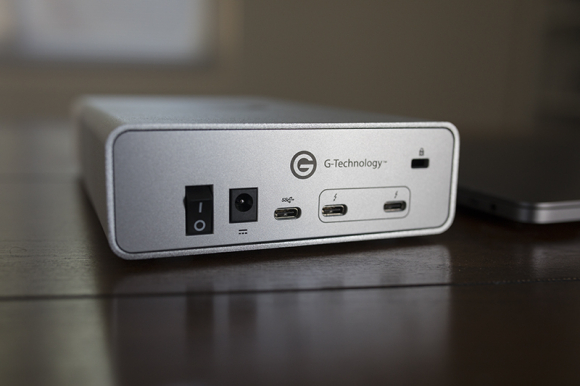
Speaking of USB, thanks to the inclusion of a USB-C port, I can even use this drive with older computers via a USB-C to USB-A cable. And the best part is, I suffer very little in terms of speed. I may not be able to daisy-chain, but I can at least connect. This is excellent for when I send drives to other team members. I am not sure what kind of computer they have or what ports they have access to, but by including three cables in the box I can rest assured that they can access the data.
I mentioned speed, and this is where the G-DRIVE can be a bit weird. That is to say, the drive is plenty fast in just about an configuration, it’s just strange where I’m seeing it run the fastest. The speed tests below were done via a 15-inch MacBook Pro with Touch Bar, with the exception of the USB-A test which was conducted on an early 2017 iMac.
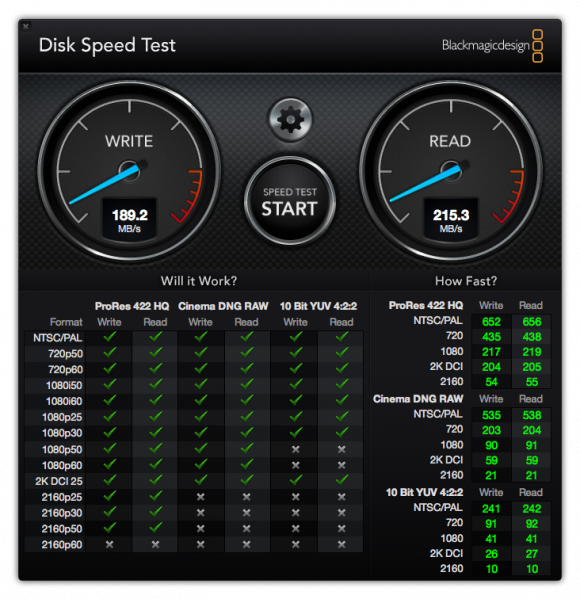
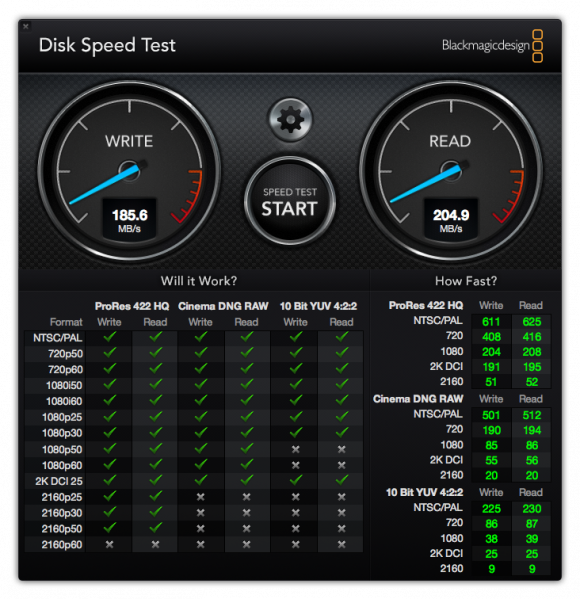
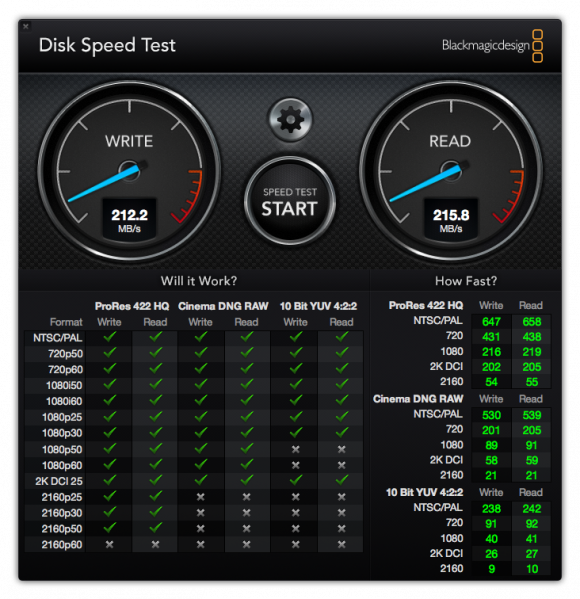
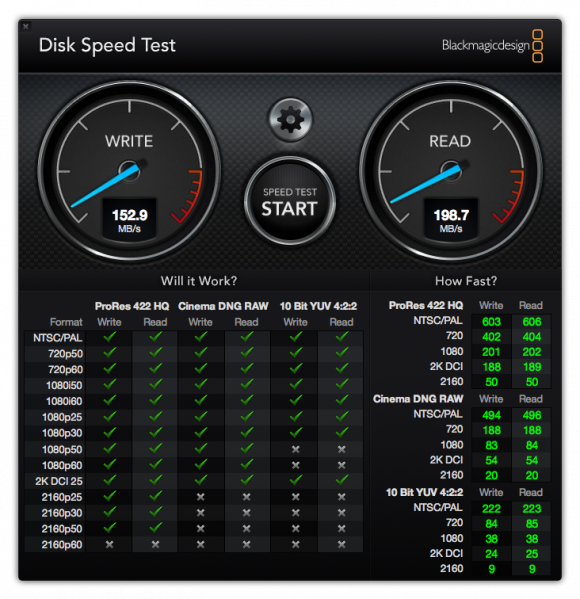
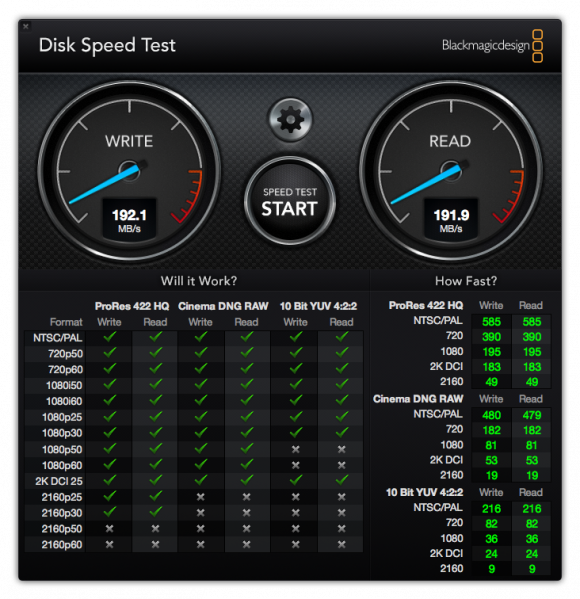
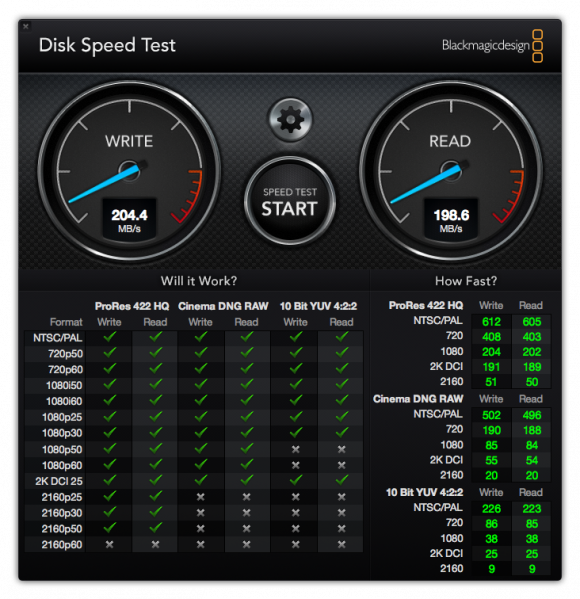
With single or even dual disk drives, modern outputs like Thunderbolt 3 aren’t really utilized to their max at all, since their max bandwidth dramatically outpaces the speed the disk could ever produce. The max bandwidth of normal USB-C and USB-3 are basically the same speed for drives like this, until I use a 10gigabit USB-C cable which will output better. But with a single disk drive like this, it’s no surprise that the speeds shown with every configuration possible hover around the same marks.
What is weird is that I can’t explain why putting a USB-C cable in the Thunderbolt 3 port produced fasted speeds than the proper cable in the same port. G-Tech did their best to show me their expected speed outputs for each type of cable, but couldn’t really tell me why my tests were showing this irregular behavior.
In the end, this kind of discrepancy doesn’t matter at all. The speed tests are showing pretty much the same performance out of all the ports via all the cables, and that’s good. We want to see that. And what’s better, you’ll get the same general speeds no matter what your setup. The only benefit to Thunderbolt 3 in this particular case is going to be the option to daisy-chain, which many will find to be a huge benefit and worth the extra money that this particular drive costs over the other options G-Tech offers.
What other options? Well, while the model I tested (G-DRIVE Thunderbolt 3 4TB) costs $350, the G-DRIVE USB-C only costs $180. What’s more, the previous drive which is simply USB-3 costs just $170. The difference among these drives might be the quality of the HDD, but it’s more likely just the connection options. If you don’t need Thunderbolt 3, then you can get a really good deal on a solid drive for much less (Prices quoted here are via reseller and are not necessarily in line with G-Technology's MAP pricing).
I was looking over the published specifications on B&H, and they aren’t the same as what G-Technologies is showing on their website. I’m going to go with G-Tech’s numbers here. They are saying the Thunderbolt 3 model can reach up to 250MB/s, which is possible perhaps on a different testing array, but the most I saw was 215 MB/s.
The USB-C G-DRIVE is quoted at 195 MB/s (it is only a Generation 1 port), and the G-DRIVE USB 3.0 is quoted at 245 MB/s. Given the speeds on these formats I tested on the Thunderbolt 3 array, you can probably expect similar results to what I’m showing on all three devices. So that said, pick the drive that’s more fitting to your personal needs.
But as far as the new Thunderbolt 3 model goes, it is an excellent device. I love the design, love the build, and especially love the options you get with the three ports. I also appreciate that the G-DRIVE features a physical on/off switch rather than a button. Both LaCie and G-Tech oscillate between giving a button and a switch, and I personally always prefer the switch. I want 100% control of when a drive is on or off, and a button doesn’t give that.
Like:
- Sleek and lightweight
- Solid construction means I won’t fear shipping it
- Very quiet in operation
- (2) Thunderbolt 3 and (1) USB-C ports
- Pretty fast read/write speeds regardless of port
- Physical on/off switch
- Multiple capacity options (4TB, 6TB, 8TB, 10TB & 12TB)
No Like:
- Oddly inconsistent speeds during testing. It would also peak to very fast speeds quickly before falling to a much lower, final speed (which are the published numbers above)
- Nearly triple the price for triple the ports, but TB3 workstations will appreciate it
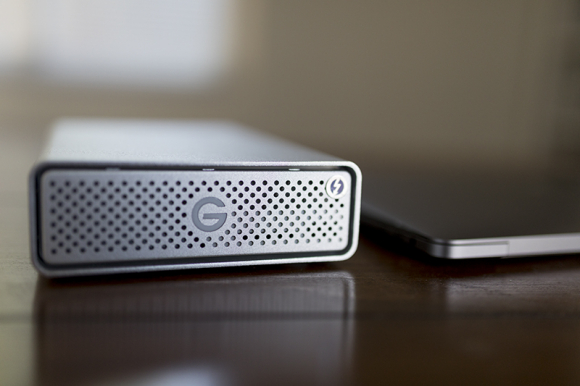
I really like the G-DRIVE because of the options it presents to me. I can connect it to several of my hard drives thanks to daisy chain, or it can still work with my slightly older iMac that doesn’t feature Thunderbolt 3. Or, I can use it with my MacBook Pro with TouchBar or even send it off to my clients or other editors full of more data than I could normally pack into a mailable drive. The G-DRIVE’s best feature is that it’s so versatile. It does what I need it to, when I need it to. That’s something I can’t say for much of the hardware I own. It’s the Swiss army knife of my storage devices, and though often I need something very specific, it’s nice to have something to fall back on in a pinch.